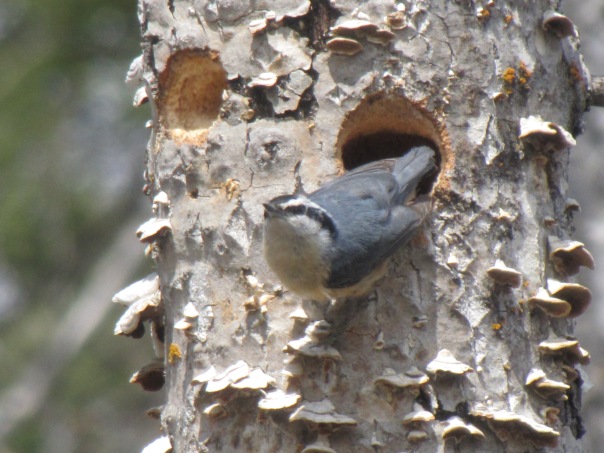A few years back, the friendly little red breasted nuthatches were swarming our feeders here in Northwestern Ontario. But last year, they were noticeably absent, and although there were lots in the late summer and early fall this year, once again, their nasal cries are missing from our yard. After receiving several calls from folks wondering if I knew the reason, I did a bit of research. Here is an article published in the Lake of the Woods Area News last year that I wrote to help understand our missing feathered friend.
Red-breasted Nuthatches – Revisited
By Lil Anderson
Previously published in the Lake of Woods Area News
This is the cry
Of souls, that high
On toiling, beating pinions, fly,
Seeking a warmer clime
From “Birds of Passage” by Henry Wadsworth Longfellow
“Where have all my nuthatches gone? Did they all die off or something? Should I have put my feeders out earlier?”
I had no answers for this caller or for previous callers voicing the same concerns. This fall, as the winter bird feeders were being set out and filled, there was a noticeable scarcity of the sweet, bold little Red-breasted Nuthatches, Sitta anadensis, that had visited feeders in North-western Ontario en masse during the winter of 2012-2013.
I remembered back in the summer of 2011, there were several breeding pairs of nuthatches on our property (Lake of the Woods Area News, Vol. 41, No. 4, July 2011, Cottage Critters). That particular year, there was an ample supply of high protein food for the hatchlings in the form of sawflies, jack pine budworm and other forest pests. And that winter and the winter of 2012, my feeders were swarming with the hyperactive little birds. But, come to think of it, I didn’t record any breeding pairs during the summer of 2013 and my feeder this fall and winter has not had a single nuthatch visit. My curiosity was peaked and I had to find the reason.
My favourite source for all things birdie is the Cornell University’s Laboratory of Ornithology. There, the little nuthatch was described as a resident, a short distant migrant or an irruptive species, depending on conditions. For example, northern populations may migrate south each year, but other populations may not migrate at all. And apparently, as was the case in 2012, Red-breasted Nuthatch migrations can be irruptive, and that particular year, the irruption was continent wide.
The consensus was that there had been a high reproductive success on the nuthatches northern breeding areas, which meant more competition for their main winter food, that being the seeds of conifers such as spruce and larch. In areas where seed production was low but bird densities were high, it made sense that large numbers of seed eaters were forced to wander in search of food. That is why in 2012, we noticed the Red-breasted Nuthatch at our feeders here in North-western Ontario at the same time our southern neighbours were seeing large numbers in the little birds most southern ranges.
The irruptions start as early as July and the migrants may reach their southern destinations in September or October. Migration back to the northern breeding grounds can start as early as March or as late as May. Irruptions can occur every 2 to 4 years.
But where were our birds during this 2013-14 winter? To find out, I checked the Ontario Field Ornithologist web site to read Ron Pittaway’s Winter Finch Forecast for 2013-14. Ron uses data collected each year across Ontario regarding the status of wildlife food crops to forecast what can be expected at our feeders each year. In particular, he focuses on the other cone seed feeders – the finches, which includes grosbeaks, crossbills, red polls, siskins and of course, Purple Finch, but he also reports on the irruptive passerines such as Blue Jays, Bohemian Waxwings and the Red-breasted Nuthatch. His prediction was that this was not an irruptive or flight year for winter finches as the cone crops were above average to excellent (which also explains the low numbers of winter finches at our feeders). And he reported that the fact there was “no movement of Red-breasted Nuthatches this year reliably predicts that spruce cone crops are heavy in the boreal forest…”
Local reporters did note occasional Red-breasted Nuthatches during their Christmas Bird Counts, likely accounting for resident populations that are always around and do not need to migrate for food. Current whereabouts of concentrations of nuthatches and winter finch will be more obvious when the continent-wide Christmas Bird Counts and Project Feeder Watch data are summarized for the winter of 2013-14. (addendum – and 2014-15)
I can’t wait to see what the resulting analysis tells us!
For more information on Red-breasted Nuthatches and their feathered friends, go to http://www.birds.cornell.edu, http://www.feederwatch.org, http://www.birdscanada.org, http://www.bsc-eoc.org or http://www.ofo.ca . These organizations are always looking for input from all over the continent of bird occurrences, bird counts, and photographs. It is this information that helps determine why our little friends fail to show up at feeders some winters.
